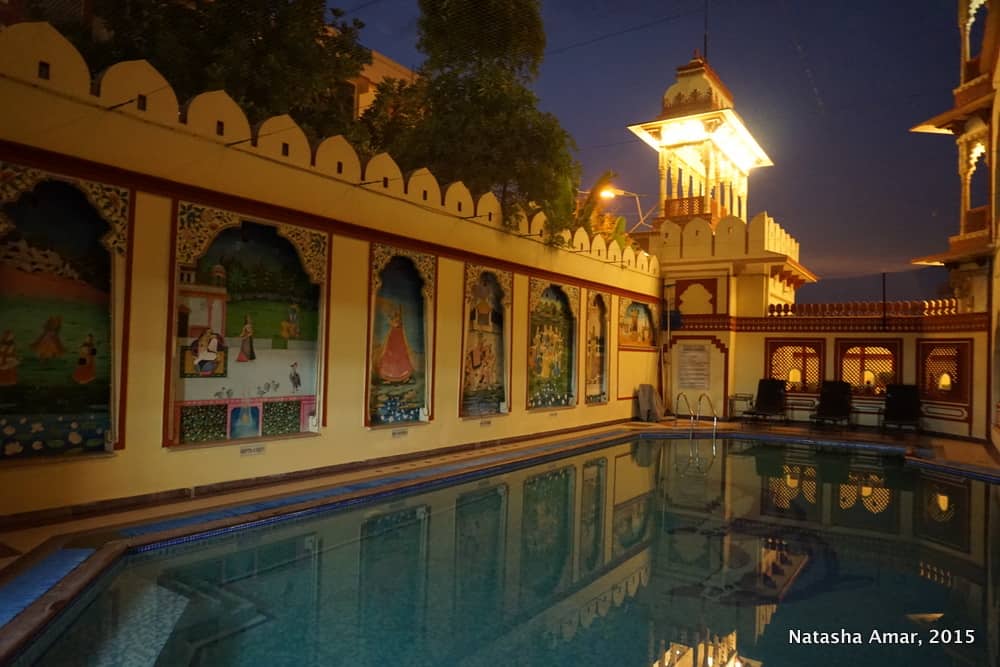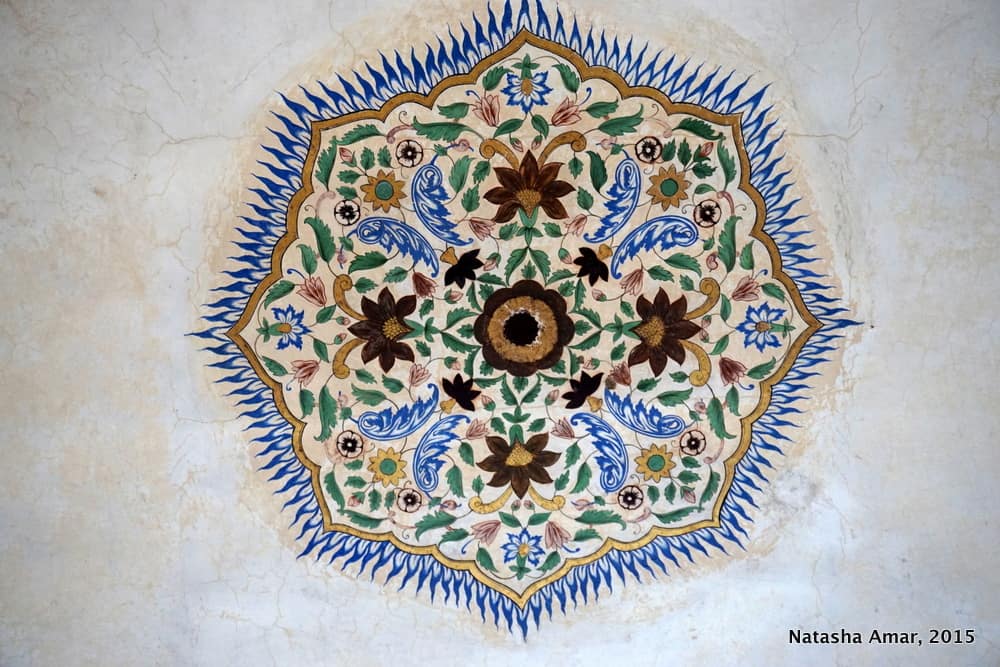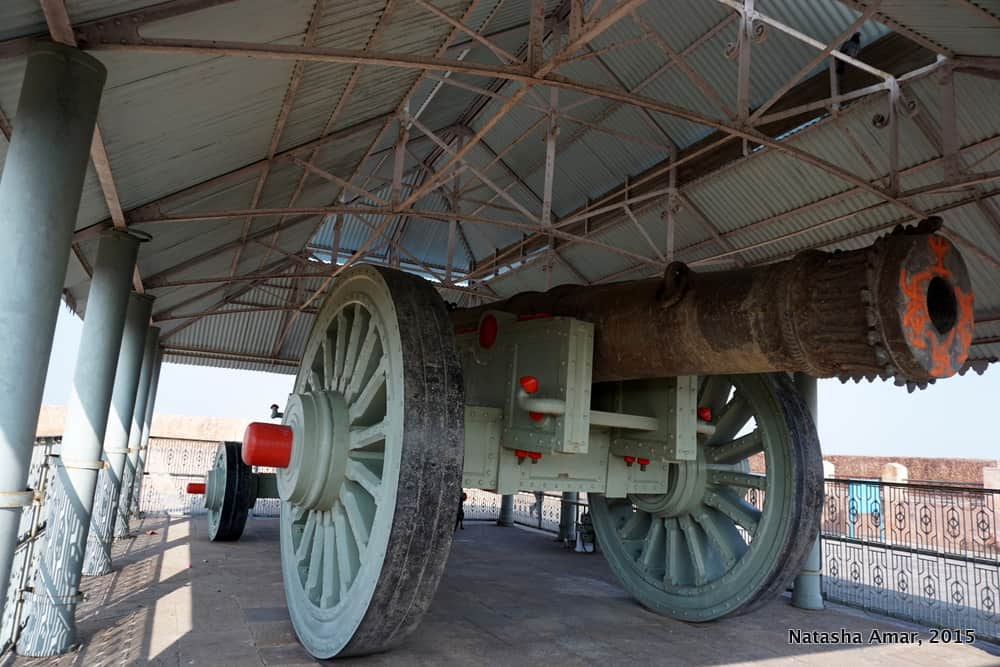Painted in soft pinks, browns, and creams, the city of Jaipur expertly juggles its two extremes; you’d be as awestruck by the grandeur of the imposing façade of the Hawa Mahal as you’d be annoyed by the incessant honking of vehicles on the road below. The bazaar streets thrive with crowds of shoppers and the persistent salesmen that keenly call out to them, even as you jump out of the way of the painted trunk of an elephant that comes casually strolling along. Often dwarfed by the fame of Udaipur, Rajasthan’s peaches and cream fairytale city, Jaipur though regard by many to be ‘not as beautiful’ deserves at least a couple of days to get acquainted with.
I’d been waiting to visit the palaces of Jaipur ever since I’d made a scrapbook of photos for a history project at the age of twelve. My curiosity only heightened after watching ‘The Best Exotic Marigold Hotel’ a brilliant film that was shot in Jaipur and Udaipur. We visited the city earlier this year to attend a friend’s wedding and arrived two days before the celebrations began so we could sightsee. After a moderately packed couple of days, I’d say three to four days are enough to see the main sights. Of course, as is the case with any city, if you’d like to get to know it better, you almost always will need to stay longer and travel slowly.
Traveling to India? Check your eligibility and apply for an online visa here.
If you only have a few days to explore, here’s my list of top things to do in Jaipur.
Top Things To Do in Jaipur
Stay at a Heritage Hotel

You could stay in a standard-ish modern hotel but that would be a boring choice in a city that has plenty of heritage and new boutique hotels. Choose from one of the many historic hotels housed in old havelis and if the idea of staying in a structure that once housed a royal doesn’t appeal to you, then pick one of the newer boutique hotels. We quite enoyed our stay at the Umaid Bhawan, a modern heritage hotel that’s built in the traditional Rajasthani style, complete with art-deco design, antique furniture, quiet courtyards, beautiful balconies and terraces, and a swimming pool.
Eat Like a Royal
A word of advice- if you like to constantly count calories, don’t visit Rajasthan. Because if you do, you won’t be able to resist the flavorsome local cuisine and there’s no good reason not to partake the joys of gluttony when in Jaipur. Tender succulent meat, rich creamy gravies, aromatic vegetable curries, and crunchy papad, there’s nothing you won’t love.
To dine like a Maharaja, order a thali, a vegetarian set meal that typically consists of an assortment of appetizers, curries, rice, rotis and dessert. Don’t forget to try these traditional delicacies:
- Dal batti churma, a dish of dal (lentil), batti (a ball of flour baked in an oven) and churma (cracked wheat, jaggery and ghee),
- Pyaz kachori (a deep-fried thick puff pastry stuffed with a spicy mixture of cooked lentil and onion),
- Ker Sangri (a vegetarian dish of the ker berry and sangria bean made using red chilies, spices and raisins).
Non-vegetarians should try the fiery Lal Maas (lamb, preparation made using red chilies and other spices), kebabs, biryani, and nihari (slow cooked meat). Indulge your sweet tooth with desserts such as ghewar (a crusty deep-fried winter dessert) and mawa kachori (sweet puff pastry).
Here are some recommended restaurants in Jaipur:
- Laxmi Mishthan Bhandar or LMB, Johari Bazaar
- Handi Restaurant, MI Road
- Niros, MI Road
- Natraj, MI Road
- Surya Mahal Restaurant, MI Road (top-end)
- Suvarna Mahal Restaurant, Rambagh Palace (this one’s a pricey affair located at the Taj Rambagh Palace)
- Choki Dhani (Tonk Road)
Visit the Palaces
If you’ve never seen an Indian palace before, prepare to be swept off your feet by the opulent remnants of the extravagant lifestyles of Indian royalty. Sightseeing in Jaipur means palace hopping from one royal residence to another.
Hawa Mahal
Perhaps the most photographed landmark in the city, the Hawa Mahal, is a beautiful pink sandstone structure built in 1799 by Maharaja Sawai Pratap Singh that offered privacy to the royal womenfolk who would view the city from its ornate windows and latticed balconies and today houses a museum within.
Visiting from Delhi? Here are some things to do in Delhi.
City Palace

Pin it!
Spend a few hours exploring the courtyards and buildings of the City Palace, of which the Chandra Mahal, still the residence of the royal family is largely closed to tourists. The architecture is a blend of Rajasthani and Mughal styles and important buildings are the Mubarak Mahal, the Diwan-i-Khas, Diwan-i-Am, and the Maharani’s Palace. These buildings house a museum, art gallery, and exhibits of royal outfits, and armory.
Amer Fort & Palace
Perched atop a hill, a short drive away from Jaipur city is perhaps the palace that evokes the strongest sense of awe- the Amer Fort and Palace. Walking around in the palace grounds, you see that the grandeur is everywhere, from the intricate glass mosaics in the Sheesh Mahal (Palace of Mirrors) and the colorful ornate Amer Gate to the gold painted details on the ceiling. The palace was the royal residence until 1727 when the last Maharaja of Amer shifted his capital to Jaipur.
It’s worth hiring a guide to hear local legends such as the stories of the Maharanis who competed for the Maharaja’s attention when he returned from battle.
Here’s a cool video of a street performer we saw on our way out:
Jaigarh Fort
Built in 1726, the Jaigarh Fort is a military fortress of watchtowers and gateways that served to protect the royal palaces and the city of Jaipur. The world’s largest cannon on wheels Jai Ban stands in the complex of the fortress and the rather surprising fact is that it was never fired! The fort itself never came under attack and its interiors aren’t as opulent as Amer Fort. An 18th-century tunnel connects the Amer Fort to the Jaigarh Fort that was built as an escape route for the royal family in case the Amer Palace was ever under attack.
The dramatic location of the Amer Fort, Jaigarh Fort and Maota Lake comes alive during the Sound and Light Show that plays twice every evening, once each in English and Hindi. Show times change through the year depending on sunset times.
Wonder at Jantar Mantar
A visit to the City Palace is incomplete without a visit to neighboring UNESCO World Heritage Site Jantar Mantar, an astronomical observatory built by Maharajah Jai Singh II in the early 18th century. At first, the complex looks like a random collection of massive geometric shaped structures; a circular dial here, a half sphere built into the ground there and a shaded viewpoint at the top of a long and narrow set of steps. But Jantar Mantar wasn’t built to indulge the fancies of some eccentric Maharaja, Jai Singh was a patron of the sciences and mathematics, and was deeply interested in the subject of astronomy.
The Jantar Mantar in Jaipur is the best preserved of the five observatories that he built in Western India. The 20 instruments were built and placed to observe astronomical positions and celestial events with the naked eye. They represent major architectural and instrumental innovations for the time in which the observatory was built. To understand how each instrument works, it’s best to hire a guide.
Shop in the Bazaars
The bazaar experience in Jaipur is exactly what you’d expect in a city that thrives on tourism. Step into bazaar territory only if you’re in a good mood and can look past the rather persuasive welcoming by the salesmen. I made the mistake of walking around in a bazaar when I was tired and a little cranky and found myself getting annoyed by the constant attention. But that was just a single experience based on my own mood so don’t let it taint your idea of Jaipuri markets in general.
If you’d like to get some shopping done, (and you probably will) spare a few hours at least to roam about a market at a leisurely pace. From locally crafted and styled mojdi shoes, jhola bags, table linen, bandi jackets and kurtas for men to jewelry such as lac bangles and minakari for women, there’s plenty to spend your cash on. Visit the Small Cottage Industries Showroom at Amer to buy beautiful sarees dyed with colors made of natural sources such as vegetables and Fullers Earth, block printed textiles, Jaipur razai (lightweight block printed quilts) suitable for use in summer and extreme winter, and orthopedic sandals made of soft camel hide.
Interesting markets to explore are Johari Bazaar, Tripolia Bazaar, Chandpol Bazaar, Kishanpol Bazaar and Sireh Deori Bazaar.
Traveling to Jaipur on a budget? Here are the best hostels in Jaipur.
Traveling to India solo as a woman? Here are the best places in India for solo female travellers.
Traveling around India? Here is a guide with things to do and places to visit in Mumbai.
If you like this post, please share it to Pinterest:
Have you been to Jaipur? What did you think about it and what would you add to this list?






























Alberto Costa
Monday 17th of July 2017
Nice blog. N great information. Jaipur is the beautiful city of Rajasthan. Photographs are really awesome.
Natasha Amar
Monday 17th of July 2017
Thank you!
Kriysti Rose
Wednesday 12th of July 2017
I loved to visit Jaipur again and again. It was a great experience and enjoyed a lot in Jaipur.
palak
Wednesday 12th of April 2017
Jaipur is the capital of India’s Rajasthan state.It's also known as Pink City.There are countless things to do in Jaipur including lavish palaces, historic forts, and massive museums.I like Jaigarh fort and always visit this fort.
Thanks for sharing such great article.
Yok
Thursday 13th of August 2015
Jaipur is fun. Actually Rajasthan is full of exciting moments and places that inspire (romanticised) dreams of another time.
Seems you have an awesome time. Did you have a chance to jump to Udaipur or Jodhpur?
thebohochica
Thursday 13th of August 2015
Unfortunately I did not, I'll have to go back to see those cities :)
Tiffany
Saturday 1st of August 2015
Great tips! I will save this for a future trip. I also love Best Exotic Marigold Hotel.
thebohochica
Saturday 1st of August 2015
Such a cool movie, isn't it!